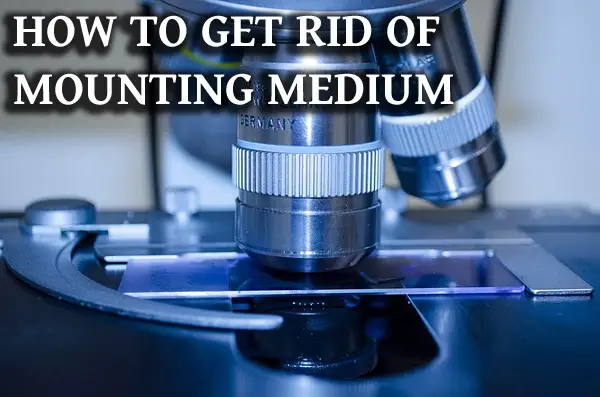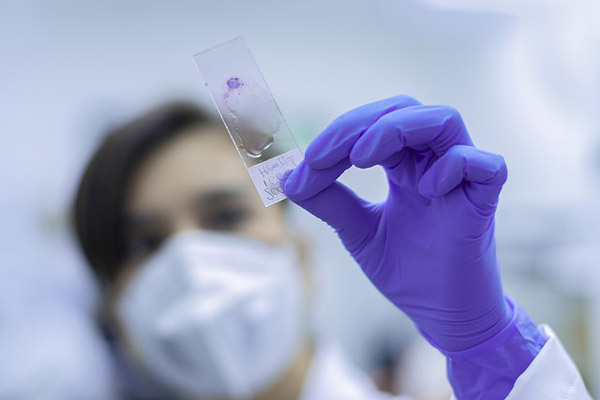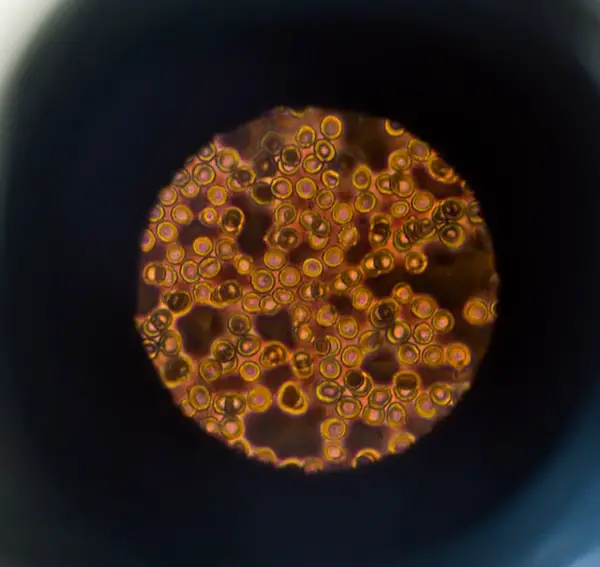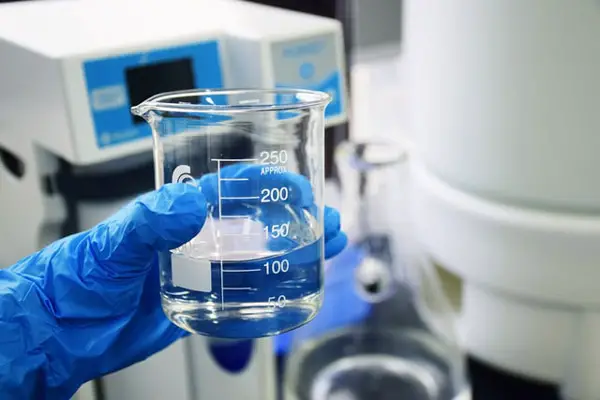You need to make some changes and restain a specimen you have on a slide but its mounted with a hardset medium and the entire specimen is permeated by the medium.

Is there a way to remove the mounting medium and reuse your tissue? Let’s find out.
There are many types of mounting media that are used to fix, or attach, a specimen to a slide. Mounting media are commonly classified into two categories: aqueous (water) based and solvent-based. The water-based ones are removed with water. The solvent-based ones are usually removed with a solvent. For commercial solutions, consult with manufacturer for best removal method. Read on for details.
A specimen is usually fixed to a slide for fixed-cell imaging. In other words, when looking under a microscope cells that are known for moving around are not the most photogenic. It is important to freeze them in place. This is why fixation techniques are used. They can also help prevent photobleaching and help with optimizing the refractive index which allows us to see certain organisms more clearly.

Media type considerations
Before you can get into what will get rid of a mounting medium, it is best to determine which mounting medium you are trying to dissolve. The two major forms of media are aqueous and solvent based media. Both require different methods of removing the media from the slide and the specimen.
Aqueous Mounting Medium:
Aqueous mounting media are water-based solutions. In fact the most basic wet mount is actual water. The most common type is a simple buffered saline solution such as PBS, or phosphate-buffered saline. Most aqueous mounting media used are soluble in PBS, water, or certain alcohols, like glycerol.
Once the sample is placed in the mounting media a coverslip can be applied. It is important at this stage to make sure there are no bubbles which could obstruct the view from the microscope.
Some examples of aqueous mounting media include:
-
Water (of course)
-
Glycerine gelly
-
Glycerol
-
Apathy’s medium
-
Farrant’s medium
-
Highman’s medium
-
Fructose syrup
-
Polyvinyl alcohol
Once coverslipped it is important to keep the samples wet. Sealants are often used to not only secure the coverslip but maintain the moisture of the sample. Paraffin wax is a commonly used sealant.
If or when ready to remove the coverslips, you can use glycerol to dissolve the wax and soak the slides in PBS. This will dissolve the mounting medium and fully free the coverslip and the sample from the slide. Please be aware that this will also remove any staining on the slide as well.

Organic Solvent Mounting Medium
For slides that are mounted using an organic substance, PBS alone isn’t going to be enough. PBS can be used as a final rinse, but it will not unmount the slides alone. For organic substances such as paraffin you must use an organic solvent such as xylene in order to remove the mounting media.
Some examples of these types of media include:
-
Canada balsam
-
Phenol balsam
-
Dammar balsam
-
Euparal
These media are great for retaining the stain when applied to a specimen and are a great way to preserve slides for long-term use. There is no need to be concerned about the sample drying out or degrading in any other way.
Many organic solvents like acetone or xylene are skin and/or respiratory irritants. It is best to make sure that all safety precautions are being taken.

Unmounting slides
In order to unmount a slide, first you have to soak the slide in a solvent until the coverslip loosens. If you applied paraffin to the sides of the coverslip, you must first dissolve this before the unmounting can begin.
Getting coverslip off
Coverslips are usually adhered to the slide with paraffin wax or another substance known as Du noyer’s wax-colophonium resin mixture. These substances are not soluble and can be difficult to remove. This is possibly the hardest part of the unmounting process. If the objective is to remove the mounting medium without degrading the sample, care must be taken.
The slide can be soaked in a solution with a small concentration of organic solvent like glycerol or xylene for a short period of time. Remove the slide and slowly remove the coverslip.
If you are trying to remove the coverslip from an aqueous medium, once you remove the coverslip you can rinse the slide in aqueous solutions like PBS or water. If you are trying to remove the coverslip from a more organic medium, you will have to soak the slide for a lot longer to remove the coverslip and the medium from the slide as these solvents are harder and take longer to dissolve.
Reusing tissue in immunohistochemistry
It is possible to reuse sections previously mounted for immunohistochemistry following the earlier mentioned steps such as by placing the slides in PBS and waiting for the coverslip to detach. You can use a detergent like Tween to get rid of the medium but if there is a previously used antibody in the tissue section you will have to leave it longer in the detergent to wash out the bound antibody. It is also not advisable for the second antibody to be from the same host animal as the first antibody used in previous mounting or you may be unclear where your signal detected under the microscope came from.
Keep in mind that reuse may not give you the best quality images from your slides, but it may be enough for a pilot study when you are limited on tissue. Its always better to use a weaker solution to remove the mounting medium for a longer amount of time than a very harsh solution for a shorter amount of time.
If you are using a commercial mounting medium you can always contact the company and ask them what is the best medium removal method that will preserve whatever you need preserved. They have a lot of experience with this both from their experiments as well as user feedback.
Getting rid of embedding medium
One of the more common techniques that requires the removal of embedding medium from slides is immunohistochemistry. This is a technique used to analyze protein expression within tissue morphology. It requires the use of antibodies and staining in order to view under a microscope. Embedding media in these instances only gets in the way.
Before the process can begin, the specimen must be processed as normal histology slides by embedding in paraffin wax and being prepared through the slicing of a microtome. Once this is completed, the medium has to be removed.
This is done through soaking in fresh xylene for 5 minutes at least 3 times. Once this is completed, the rest of the process can continue. Soaking in fresh xylene doesn’t remove all of the medium because the specimen is still adhered to the slide. It also helps to rehydrate the specimen. However, it does remove enough to allow the antibodies and stain to adhere to the surface of the specimen.
Once this process is completed, the slides will go through another coverslipping process and be viewed under the microscope. This is a fairly tedious process that takes a few hours, but removing the slide medium is actually fairly quick.
Summary
There could be numerous reasons in which a person would want to remove the slide medium from a slide. Whether it is to start an experiment from scratch and reuse the slide or for such highly technical experiments like immunohistochemistry. The key elements are to fully determine the type of slide medium you are attempting to remove and the appropriate solvent. After that, the only thing that matters is time to remove the coverslip and remove the actual medium within the solvent.
Below is a useful video on mounting slides:
Click on the following link to learn how to make microscope mounting medium.
Recent Posts
Mastering point cloud to 3d model conversion can feel like translating whispers from another dimension into vivid sculptures. You've got this cloud of data points, a chaotic concert of coordinates...
Let's say you've got a drawing, something you sketched out during a burst of inspiration, and now you're itching to see it leap off the page into three dimensions. Well, that’s exactly what I did...
